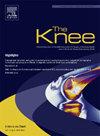Correction of severe varus deformity in total knee arthroplasty with the technique of tibial plateau reduction
IF 1.6
4区 医学
Q3 ORTHOPEDICS
引用次数: 0
Abstract
Background
The optimal soft tissue release technique for severe varus total knee arthroplasty (TKA) remains controversial. The technique of tibial plateau reduction was suggested for severe varus deformity during TKA. The purpose of this study was to evaluate the clinical and radiological outcomes of the technique of tibial plateau reduction.
Methods
Fifty-one knees (39 patients) with a mechanical femoro-tibial angle (MFTA) greater than 15° treated with TKA was presented. The clinical and radiographic data were gathered prospectively. The patients were divided into two groups according to the preoperative angle: Group A comprised patients with a preoperative MFTA less than or equal to 20°, while Group B included patients with a preoperative MFTA greater than 20°.
Results
Among the 51 knees, 46 knees (90.2%) had femoro-tibial component size mismatch. The KSS-KS improved from preoperative 39.9 ± 11.3 points (range:18–68 points) to 92.3 ± 5.2 points (range: 83–100 points) at the final follow up (t = 30.141, P < 0.001); the KSS-FS improved from preoperative 48.0 ± 11.5 points (range: 31–71 points) to 87.2 ± 8.7 points (range: 63–100 points) at the final follow up (t = 19.413, P < 0.001). The mean MFTA was corrected from 21.0 ± 4.7° preoperatively to 2.9 ± 1.8° at the latest follow up (P < 0.001). The preoperative MFTA was less than or equal to 20° in 27 knees (Group A), and greater than 20° in 24 knees (Group B). The mean postoperative MFTA was 1.9 ± 0.9° in Group A, and 4.1 ± 1.7° in Group B (P < 0.001). The neutral limb alignment was reached in 26 knees (96.3%) in group A, which was significantly higher than that in group B (29.7%) (P = 0.019).
Conclusions
The technique of tibial plateau reduction provided satisfactory clinical and radiological outcomes without instability for severe varus TKA. However, surgeons should remain aware that the greater the preoperative varus deformity, the greater the postoperative residual varus deformity, and that there is a high incidence of femoro-tibial component size mismatch using the technique.
胫骨平台复位技术矫正全膝关节置换术中严重内翻畸形。
背景:重度内翻全膝关节置换术(TKA)的最佳软组织释放技术仍然存在争议。对于TKA中严重的内翻畸形,建议采用胫骨平台复位技术。本研究的目的是评估胫骨平台复位技术的临床和放射学结果。方法:对39例机械股胫角(MFTA)大于15°的51例膝关节进行TKA治疗。前瞻性地收集临床和影像学资料。根据术前角度将患者分为两组:A组为术前MFTA小于等于20°的患者,B组为术前MFTA大于20°的患者。结果:51个膝关节中,46个膝关节(90.2%)存在股胫骨假体尺寸不匹配。KSS-KS评分由术前的39.9±11.3分(范围:18-68分)提高到最后随访时的92.3±5.2分(范围:83-100分)(t = 30.141, P)。结论:胫骨平台复位技术治疗严重内翻TKA临床及影像学结果满意,无不稳定性。然而,外科医生应该意识到,术前内翻畸形越大,术后残留的内翻畸形也越大,并且使用该技术时,股骨-胫骨部件尺寸不匹配的发生率很高。
本文章由计算机程序翻译,如有差异,请以英文原文为准。
求助全文
约1分钟内获得全文
求助全文
来源期刊

Knee
医学-外科
CiteScore
3.80
自引率
5.30%
发文量
171
审稿时长
6 months
期刊介绍:
The Knee is an international journal publishing studies on the clinical treatment and fundamental biomechanical characteristics of this joint. The aim of the journal is to provide a vehicle relevant to surgeons, biomedical engineers, imaging specialists, materials scientists, rehabilitation personnel and all those with an interest in the knee.
The topics covered include, but are not limited to:
• Anatomy, physiology, morphology and biochemistry;
• Biomechanical studies;
• Advances in the development of prosthetic, orthotic and augmentation devices;
• Imaging and diagnostic techniques;
• Pathology;
• Trauma;
• Surgery;
• Rehabilitation.
 求助内容:
求助内容: 应助结果提醒方式:
应助结果提醒方式:


